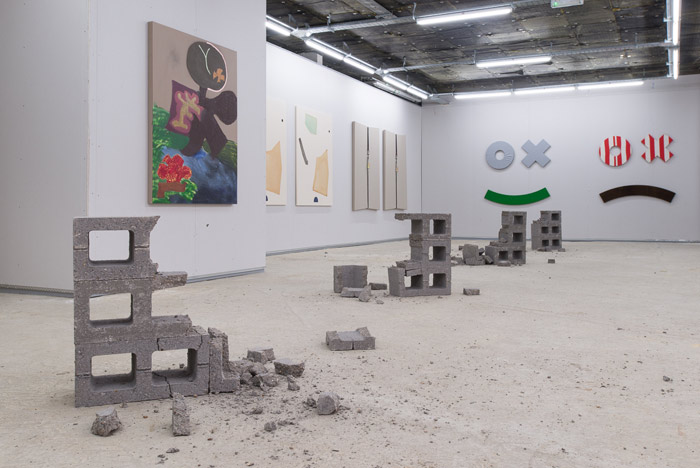“I’m just one hundred and one, five months and a day.”
“I can’t believe that!” said Alice.
“Can’t you?” the Queen said in a pitying tone. “Try again: draw a long breath, and shut your eyes.”
Alice laughed. “There’s no use trying,” she said.
“One can’t believe impossible things.”
“I daresay you haven’t had much practice,” said the Queen.
“When I was your age, I always did it for half-an-hour a day. Why, sometimes I’ve believed as many as six impossible things before breakfast.”
-Lewis Carroll, Through the Looking-Glass, and What Alice Found There, 1871
The six New York based artists featured in Six Impossible Things Before Breakfast at Rod Barton, London make destructive, reconstructive, and experimental gestures through the renegotiation of material. These bold, process-based approaches to painting and sculpture mark the inaugural exhibition at Rod Barton’s new space in Peckham, South London.
The viewer is confronted immediately by the theatrics of Dylan Lynch’s four Untitled 2013 sculptures. Here, four separate stacks of three partially smashed Breeze Blocks are centered along the nave of the gallery on the concrete floor. The crumbled grey remnants precariously rest on the floor beside the stacks, left as evidence of the previous action. Upon being partially destroyed the block’s functions are negated. Inverted, the once substantial blocks now are vulnerable and surprisingly delicate. On the back wall, Grear Patterson’s applies a similar reuse to material, tarpaulin, originally used as a waterproofing fabric. In green and grey, Distinguished Grey, 2013 and red and white striped and black, La Brea, 2013, Patterson stretches the material in a comedic and unexpected manner, into two large emoticons. Each work is made from three separate symbols, the bracket shaped mouth, one “X” as one winking eye, and one “O” as the other eye, the combination here making the whole of each face. The image is familiar yet re-imagined both in material, scale, and context as a deconstruction and recombination of the simple signs that create language.
To the left of these works artist’s Morgan-Richard Murphey and Landon Metz both present pairs as a forum to experiment with material. In the Case of Morgan-Richard Murphey, two pristine, raw, grey belgium canvasses are assaulted by a singular toe strap vertically centered on each of the canvases respectively. The viewer is left to bear witness to the tension created through the action of tightening the straps, the aluminum stretcher bars are crushed and distorted under the pressure of the applied tension. Metz displays the limits of materials as the work similarly to Lynch Next, in his two Untitled, 2013 works, a pair of dye and canvas paintings address the notion of impossibility through a much more idiosyncratic process. In this instance, Metz pours dye onto pre-stretched raw canvas and then moves the canvas so the dye pools and creates geometric forms. Once one work is completed, Metz attempts to re-create the same work. Here his making is confined to the physics of organic materials and the precision of the artists hand. The dried ink washes in their geometric pattern resemble the tones of a glass mosaic. Chance becomes a pinnacle factor in the creations of his work.
Ross Iannatti’s quilt-like sewn arrangements of exploded car airbags also apply a chance element and an intuition to a traumatic material. Here in 3 works titled Hysteresis no.60 (with two consecutive 61 and 62) the revitalization of the airbags allows for the possibility of beauty to be extracted from the remnants of the chemicals and dirt of disaster. One can only speculate the haunting narratives of these three works sandwiched between the somewhat more direct, yet equally imaginative narratives of Torey Thornton in Original Wild Thornberry View, 2013 and Amongst A Portobello Fly, Holding Towel, 2013. Harkening back perhaps to the fairy tale scene found in the opening quote from Lewis Carroll’s Through The Looking Glass, Thornton uses painting and fantastic titles to tell a wonky story. In pastel colors, crude almost representational forms of trees or human figures employ a language of their own, like Patterson, and a playful fresh exchange with traditional art material, like Metz.
Impossibility then, need not be a dead end, but rather a starting point—a way through, as shown here by the inventive actions of these young artists.
By Cory Scozzari
























